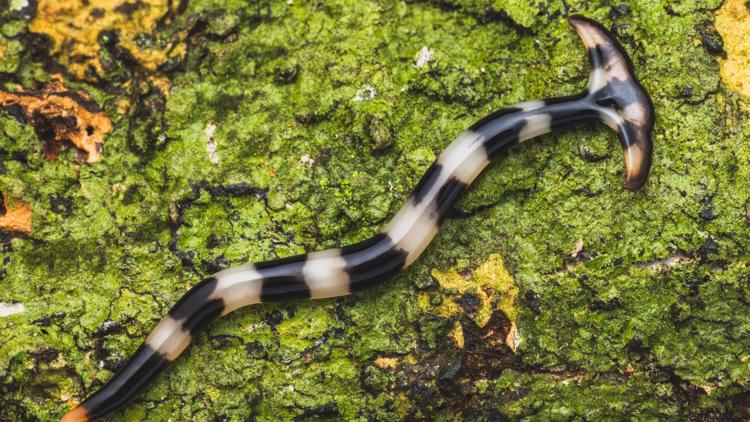HOUSTON — Earthworms, as we know, are garden champions, cleaning the soil by eating their weight in organic matter every day and aerating it as they wriggle around, creating tunnels to ease root growth. They also improve soil moisture, remove fungal spores and stimulate microbial activity, which benefits plant health.
But there’s another weird worm out there that’s toxic, deadly to our beloved earthworms, and nearly impossible to kill – the hammerhead worm.
These toxic worms have made headlines in Texas before, especially since they can thrive in a hot and humid climate.
As its name would imply, the narrow, snakelike flatworm has a head built like that of a hammerhead shark. And it’s hardly a newcomer, believed to have hitched a ride to the U.S. from Southeast Asia with a shipment of plants around 1900.
Usually 2 to 3 inches in length with vertical stripes running the length of their bodies, the invertebrates can grow up to 15 inches long. And they’re a force to be reckoned with.
Although they are ravenous earthworm hunters, hammerheads are coated in the same paralytic neurotoxin present in pufferfish, which keeps birds and other insects from preying on them. This gives them a decisive advantage in the food chain.
That chemical coating is toxic to pets and would likely irritate your skin if you were to pick up a worm. To add insult to injury, their bodies contain parasitic nematodes, tiny roundworms that feed on plants and can parasitize humans, animals, and beneficial insects.
As carnivorous cannibals, the worms eat snails, slugs and each other (no love lost there), as well as earthworms, the loss of which would pose a catastrophic threat to farms and gardens.
Hammerhead worms are hermaphroditic, so they reproduce without a mate. But that’s not the only way they multiply: Their favorite party trick is detaching a portion of their rear ends and leaving them on plants, where, within 10 days -- presto, chango! – those little butts grow heads and become offspring. If you were to chop a hammerhead worm to bits, each would grow into a new hammerhead worm. Don’t do it.
The slithering pests love heat and humidity, so they initially made their homes in Alabama, California, Florida, Georgia, Louisiana, Mississippi, South Carolina and Texas. But greenhouses are also hot and humid, so the worms have been inadvertently transported on nursery plants to gardens in Arkansas, Illinois, Kentucky, Massachusetts, Michigan, Missouri, North Carolina, New Jersey, New York, Ohio, Oklahoma, Tennessee, Virginia and Washington, D.C. They’ve also been found in Hawaii and Ontario, Canada.
Preferring to hide under leaf litter, shrubs, rocks, and logs, the worms can go largely unnoticed.
What to do if you find a hammerhead worm
Morgan Young with our sister station, WFAA, reported on the worms, saying if you find them, put on some gloves, put them in a plastic bag with salt and vinegar or citrus oil and throw them in the freezer overnight. One thing you don’t want to do is cut it into pieces.
“It will regenerate,” said Ashley Morgan-Olvera, M.S., with the Texas Invasive Species Institute. “So if you chop it into two pieces, you get two worms.”
Don’t touch it even after it’s dead. Immediately wash your hands with soapy water and rinse them in alcohol or a hand disinfectant.
If you find a hammerhead flatworm, Morgan-Olvera told us in a previous story to send a photo and the address where it was found to invasives@shsu.edu. That way the department can track the data.



